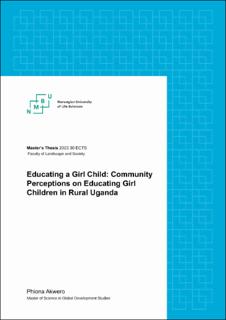| dc.contributor.advisor | Professor Darley Kjosavik | |
| dc.contributor.author | Akwero, Phiona | |
| dc.date.accessioned | 2023-07-18T16:28:02Z | |
| dc.date.available | 2023-07-18T16:28:02Z | |
| dc.date.issued | 2023 | |
| dc.identifier | no.nmbu:wiseflow:6839519:54591666 | |
| dc.identifier.uri | https://hdl.handle.net/11250/3079896 | |
| dc.description.abstract | There is paucity of information regarding perceptions of the importance of girl child education in the rural communities of Uganda. And yet the country has programs that foster girl child education such as the Universal Education System (UES) for primary and secondary level, the National strategy for girl's education in Uganda (2015-2019) (Ministry of Education and Sports, (MoES) (2013). The study embarked on using a cross-sectional research design with both qualitative and quantitative methods to investigate the current community perception of the importance of educating a girl child in Uganda’s Rural context. Sixty household interviews were conducted for quantitative data. Three FGDs and Eight Key informants were deeply interviewed. Thematic and content analysis and Descriptive statistics were used together to analyze the data. Results revealed that although the rural communities are trying to take a positive lens towards girl child education due to the benefits such as supporting their families, reduced early marriages and infant mortality rate, increase in respect and value for girls and their family, participation in leadership and effective decision making and increased literacy and self-esteem among girls, there is still a big challenge of failure to afford school fees and requirements, poor parenting, society perceptions and cultural stereotypes, long distances to school, child labor and parental loss that act as barriers to girl child education at community/household level. The other is the unfriendly school environment to a girl child ranging from teacher-student affairs (Rape and defilement), limited girl child support, and peer influence. Different strategies and institutions have come to advocate for girl child education by offering scholarships and formulating policies among others. In conclusion, girls still grapple with barriers ranging from home-based/community to school-based constraints to accessing education. Poverty, and cultural norms, attitudes, traditions, and stereotypes are still a big hindrance to a girl’s education. There is a need to strengthen community sensitization of the importance of girl child education. Facilities such as boarding sections for girls and girl centers in addition to education institutions could be established. Girl centers can build self-esteem and act as quick responses to urgent issues that may hinder girl child education including rape and defilement. Also, the enhancement of incomes of the parents or poverty alleviation projects could raise the household income levels, which would enhance parents’ ability to support girl children’s education. | |
| dc.description.abstract | There is paucity of information regarding perceptions of the importance of girl child education in the rural communities of Uganda. And yet the country has programs that foster girl child education such as the Universal Education System (UES) for primary and secondary level, the National strategy for girl's education in Uganda (2015-2019) (Ministry of Education and Sports, (MoES) (2013). The study embarked on using a cross-sectional research design with both qualitative and quantitative methods to investigate the current community perception of the importance of educating a girl child in Uganda’s Rural context. Sixty household interviews were conducted for quantitative data. Three FGDs and Eight Key informants were deeply interviewed. Thematic and content analysis and Descriptive statistics were used together to analyze the data. Results revealed that although the rural communities are trying to take a positive lens towards girl child education due to the benefits such as supporting their families, reduced early marriages and infant mortality rate, increase in respect and value for girls and their family, participation in leadership and effective decision making and increased literacy and self-esteem among girls, there is still a big challenge of failure to afford school fees and requirements, poor parenting, society perceptions and cultural stereotypes, long distances to school, child labor and parental loss that act as barriers to girl child education at community/household level. The other is the unfriendly school environment to a girl child ranging from teacher-student affairs (Rape and defilement), limited girl child support, and peer influence. Different strategies and institutions have come to advocate for girl child education by offering scholarships and formulating policies among others. In conclusion, girls still grapple with barriers ranging from home-based/community to school-based constraints to accessing education. Poverty, and cultural norms, attitudes, traditions, and stereotypes are still a big hindrance to a girl’s education. There is a need to strengthen community sensitization of the importance of girl child education. Facilities such as boarding sections for girls and girl centers in addition to education institutions could be established. Girl centers can build self-esteem and act as quick responses to urgent issues that may hinder girl child education including rape and defilement. Also, the enhancement of incomes of the parents or poverty alleviation projects could raise the household income levels, which would enhance parents’ ability to support girl children’s education. | |
| dc.language | eng | |
| dc.publisher | Norwegian University of Life Sciences | |
| dc.title | Educating a Girl Child: Community Perceptions on Educating Girl Children in Rural Uganda | |
| dc.type | Master thesis | |
